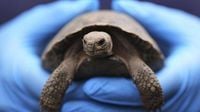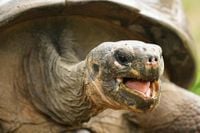On August 20, 2025, the Philadelphia Zoo rolled out the red carpet—literally—for sixteen hatchlings that may help secure the future of their species. These aren’t just any baby animals, either. They’re western Santa Cruz tortoises, a critically endangered species native to the Galapagos Islands, and their arrival marks a significant milestone in conservation efforts worldwide.
The story of these hatchlings begins with their parents, affectionately known as Mommy and Abrazzo. Both are estimated to be around 100 years old, making them among the oldest inhabitants of the Philadelphia Zoo. Mommy has called Philadelphia home since 1932, arriving at the zoo when she was just a few years old. Despite her long tenure, she had never produced offspring until Abrazzo joined her nearly five years ago from the Riverbanks Zoo and Garden in Columbia, South Carolina. Their partnership has now resulted in the first offspring for Mommy, a momentous occasion for both the zoo and the broader conservation community.
According to The Associated Press, the hatchlings were treated to a slow walk and a special event, drawing admiration from staff and visitors alike. Animal care specialists, who have watched over the eggs since they were laid, proudly displayed the hatchlings in front of the zoo’s tortoise habitat. The young tortoises are reportedly eating well and growing, much to the delight of their caretakers.
Lauren Augustine, the zoo’s director of herpetology, captured the gravity of the moment in a statement to The Associated Press, saying, “Now this animal, who’s been in Philadelphia since 1932, will be represented here for, hopefully, another 100 years because her offspring are now part of our collection.” Her words reflect not just pride, but hope—a hope that these hatchlings will help preserve the genetic legacy of their species for generations to come.
What makes the arrival of these hatchlings even more special is their backstory and the careful attention to their individual identities. The sixteen tortoises hatched in a series of clutches throughout the spring and summer of 2025. Four females, who emerged early in the spring, were named after characters from the beloved television show “Golden Girls.” In April, three males joined the group, followed by Mommy’s second clutch, which produced three females in June and six males over the summer. The zoo has gone to creative lengths to distinguish each hatchling, using nontoxic nail polish in different colors and bestowing them with names like Zee, James, Colette, Soledad, Isabelle, Roger, Fausto, Caldero, Lee, Marigold Puddlefoot, and Kelpy. The zoo is even encouraging donors to suggest a name for one of the male hatchlings, subject to approval—a clever way to involve the public in this conservation success story.
The western Santa Cruz tortoise is one of thirteen living species of tortoise native to the Galapagos archipelago, specifically the western portion of Santa Cruz Island off the coast of Ecuador. These remarkable creatures are the largest species of tortoise in the world and are believed to live as long as 200 years. Yet, their future is far from secure. According to 2016 statistics from the International Union for Conservation of Nature (IUCN), there were only about 3,400 mature individuals left—a staggering drop from historic numbers. The birth of sixteen new hatchlings, therefore, is not just a cause for celebration; it’s a tangible step forward in the fight against extinction.
As reported by the Mirror US, the hatchlings are expected to remain at the Philadelphia Zoo for at least a year before being moved to other accredited facilities next fall. This strategy ensures that the young tortoises will receive the best possible care during their formative months, while also maximizing their contribution to the broader conservation effort. Their eventual relocation will help maintain genetic diversity across different zoos and institutions, a critical factor in the long-term survival of the species.
Mommy and Abrazzo’s story is not unique in the world of tortoise conservation, but it is certainly inspiring. Their offspring are seen as highly genetically valuable, and their successful breeding is a testament to the dedication of the zoo’s animal care specialists. “Their offspring are considered a win in the effort to preserve western Santa Cruz tortoises,” noted the Philadelphia Zoo, underscoring the significance of this event.
The celebration of these hatchlings comes at a time when tortoises are receiving increased attention in the conservation world. In June 2025, Zoo Miami announced that Goliath, a 135-year-old Galapagos tortoise, became a father for the first time, further highlighting the resilience and longevity of these ancient reptiles. The Philadelphia Zoo, for its part, is also home to two giant Aldabra tortoises named Wilma and Betty, adding to its impressive roster of long-lived and charismatic animals.
Visitors to the zoo have been charmed by the sight of the hatchlings, who, despite their tiny size, carry the weight of their species’ future on their backs—quite literally. The zoo’s efforts to engage the public, from the creative naming process to the red carpet debut, reflect a broader commitment to education and community involvement in conservation. It’s not every day that you get to witness a species on the brink of extinction take a small but meaningful step back from the edge.
Of course, challenges remain. The population of wild western Santa Cruz tortoises is still a fraction of what it once was, and threats like habitat loss, invasive species, and climate change continue to loom large. But the birth of these sixteen hatchlings offers a rare glimmer of hope—a reminder that, with patience, dedication, and a little bit of luck, even the most endangered creatures can find a way forward.
As the Philadelphia Zoo continues to care for its newest residents, the world watches with anticipation. Will these hatchlings grow up to help repopulate the Galapagos Islands? Only time will tell. For now, though, they represent a victory—however small—in the ongoing struggle to protect our planet’s most vulnerable species.
In the quiet corners of the zoo, beneath the watchful gaze of their century-old parents, sixteen tiny tortoises are taking their first steps. Their journey is just beginning, but thanks to the tireless efforts of conservationists and the support of an engaged public, their future looks just a little bit brighter.

